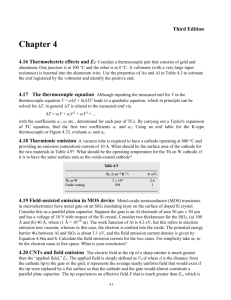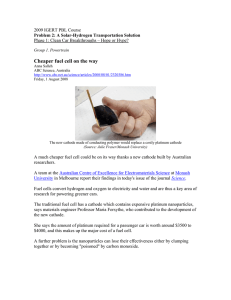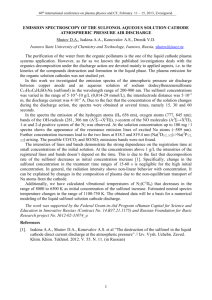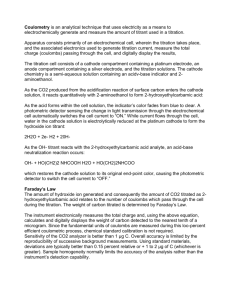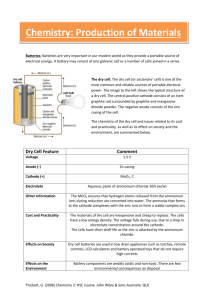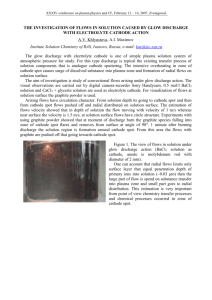Experimental Studies of Local and Global Injection Gun PSFC/JA-05-1
advertisement
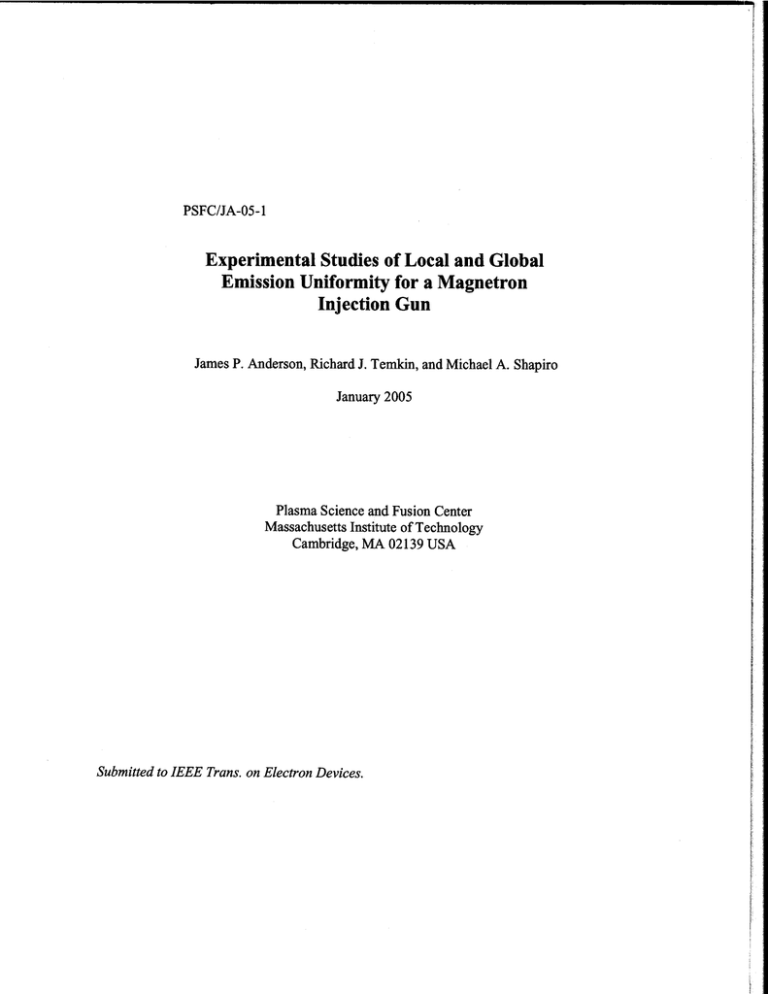
a PSFC/JA-05-1 Experimental Studies of Local and Global Emission Uniformity for a Magnetron Injection Gun James P. Anderson, Richard J. Temkin, and Michael A. Shapiro January 2005 Plasma Science and Fusion Center Massachusetts Institute of Technology Cambridge, MA 02139 USA Submitted to IEEE Trans. on Electron Devices. 11l 1 Experimental Studies of Local and Global Emission Uniformity for a Magnetron Injection Gun James P. Anderson, Richard J. Temkin, and Michael A. Shapiro Plasma Science and Fusion Center, Massachusetts Institute of Technology, Cambridge, MA 02139 Abstract We report measurements of the azimuthal emission nonuniformity of a gyrotron's thermionic cathode as determined from two experiments, one which determines the total emission and one which scans the emitted beam using a rotating probe. In the total emission experiment, which measured the total collector current over a range of voltages, the cathode's total work function spread was found to be 0.033 eV at T = 1000 'C, centered around 1.88 eV. In the subsequent experiment, which used a mechanically rotatable current probe, global and local effects were investigated. Voltage was varied to examine emission nonuniformities in different regions of cathode operation. While emission became almost completely uniform in the low-voltage space-charge limited regime, emission varied as much as 50 % at high voltages. In another part of the current probe experiment, current-voltage (I-V) curves were measured at azimuthal locations in 300 increments for several cathode temperatures. From this extensive set of data the work function distribution parameters were identified over small sections of the cathode for the entire cathode surface. The efficiency of microwave radiation produced by high power microwave sources is particularly sensitive to the electron beam quality. The beam for these devices must have low momentum and energy spread along with high spatial emission uniformity to ensure the best possible efficiency. High power gyrotrons extract microwave energy from an annular electron beam produced from a thermionic cathode in a magnetron injection gun (MIG). Theoretical studies [1] and experimental research [2], [3] of gyrotrons have shown that the emission uniformity of the annular beam can have a significant effect on the amount of energy available for exciting a particular electromagnetic mode. Mode competition due to an electron beam of poor quality may severely limit the efficiency of a gyrotron. The electron beam quality is largely dependent on the quality of the cathode. For a gyrotron cathode the quality is determined by both its temperature uniformity and its work function uniformity. Cathode emission is generally described by two equations, the Child-Langmuir law, in the low-voltage space-charge limited regime, and the Richardson-Dushman equation, in the high-voltage temperature limited regime. Numerous studies have attempted to model the transition between these two regimes of operation [4][5]. One approach, which is used in this study, assumes distributed parameters to comine the two equations into one expression [6]. For a work function distribution which is Gaussian, with a central work function value 0, and work function spread o, the emission current density JV at a particular voltage value V may be expanded to [7]: KV I/2 Jv (0 0, a) = 2 2 # 1 +1erf (uV eE_ 0-TkT41rEo exp [-e o 2 '4 + 2 4 - erf O av 21 + x eu 2kT (1) where K is the perveance of the beam (dependent on cathode geometry), A is the Richardson constant, 0 120 A/cm 2 deg2 , T is the cathode temperature, e is the electron charge, Eo the free-space permittivity, and k is Boltzmann's constant. E is the electric field which contributes to the Schottky effect. The transitional work function OT is the work function at the threshold voltage where the space-charge limited current equals the temperature-limited current, as described in [7]. Note this expression is derived assuming the cathode has a spread only in its work function, not in temperature. Emission Gate Valve Superconducting Magnet MIG Electron Gun Bcam Tunnel Anmi. Cwratpla *- Fig. 1. The diagnostic used for measuring the beam current at a particular azimuthal angle consists of a copper cylinder, which the electron beam enters, and a narrow beam slot, through which a small angular section of the beam exits. This portion of the beam current is measured by a current plate, fixed above the beam slot. The probe structure is rotated around the azimuth to sample the beam current at various angles. nonuniformity due to a temperature distribution for a gyrotron cathode has been shown, both from theory and direct measurement [7], to be small compared to nonuniformities caused by a spread in the cathode's work function for most MIG guns. The temperature spread therefore will be ignored. As discussed in previous papers [7]-[9], a distinction may be made between global and local work function spreads. The global spread aglobal is due to macroscopic variations over the entire surface of the cathode. On a much smaller spatial scale, a work function distribution, independent of the global spread, may also be measured. This local spread 0Xocal may be caused by the amount of barium surface coverage at the microscopic level, which in turn may be influenced by the pore sizes, which are less than ten microns. The total spread for the cathode's work function is a summation of these two independent effects: UTotal = aglobal + 0 locat (2) An experiment was designed at MIT to measure the local and global work function spread of a cathode used in a 96 kV, 40 A gyrotron magnetron injection gun (Fig. 1). The experiment included a current probe consisting of a cylindrical copper collector with a narrow 10' slot cut along the side. A metal collector plate was located above the slot to measure the amount of beam current which exits the slot. The probe was then mechanically rotated to sample the beam current at various angles around the azimuth. The gun was operated at high voltages in short (3 ts) pulses. Initial results using an earlier gyrotron cathode were reported in [7]. Due to activation difficulty, that cathode has since been replaced by a new cathode, identical in design but with a slightly different surface coating and mixture (see Table I). Extensive measurements were taken of the new cathode using the same experimental setup (Fig. 1). The data points shown in Fig. 2 were recorded by guiding a beam to the current probe and measuring the total current, the sum of the collector current and slot current, over a range of voltages. The cathode temperature was also varied. The data set was fit using Equation 1 to determine the central work function value 00 and spread U for the cathode at each temperature. In this case, the total work function spreads OTotal are represented, since the entire collector current was measured and used in the calculations. The central work function value 00 for this M-type tungsten cathode was around 1.88 eV for each temperature. For the data shown in Fig. 2, the fit using Equation 1 gave a work function spread of 0.046 eV at T = 965 'C, 0.042 eV at T = 975 'C, and 0.033 eV at T = 1000 'C. This decrease in work function spread with increasing temperature agrees with previous observations [6]. .- 50 1000 *C 40 975 *C F 30 .- s-~~ 20 965 *C 10 0 1 2 x10 7 V3/2 (Volts3/2) Fig. 2. I-V curves and their best fit for total collector current at various temperatures. For the data shown, # = 1.88 eV for all temperatures. The spread, UTOtal was 0.046 eV at T = 965 *C, and 0.042 eV at T = 975 OC. At the highest temperture, T = 1000 *C, the spread decreased to 0.033 eV. Emitter Surface Finish Impregnate Ratio Coating Old Cathode [7] 16 microin. RMS 5:3:2 TA New Cathode 32-64 microin. RMS 4:1:1 M TABLE I Comparison of old and new cathodes. Next, to examine local and global work function variations, the probe was mechanically rotated, and the azimuthal change in probe current was measured. In the first part of this experiment, the temperature was fixed at T = 1000 'C, while the voltage was varied for each scan. Fig. 3 shows the results of these measurements. Note each scan was performed multiple times to verify the repeatability of the experiment. The voltage was not increased past 70 kV, mainly due to the noise present in the measurement system at higher voltages. As the results show, the voltage, above 50 kV, did not affect the azimuthal uniformity of the beam. This was because the cathode at those voltages was fully temperature-limited. When the voltage decreased below 50 kV, emission became more uniform. In this case, more sections of the cathode had become space-charge limited. Neither the cathode's work function nor its work function spread have an effect on current emission in the space-charge limited regime. When the voltage became very small, ~2.5 kV, the current azimuthal distribution was almost completely uniform. A small sinusoidal variation was observed, which may be explained by an offset error of 0.3 mm in the transverse positioning of the cathode with respect to the anode. The high-voltage data in Fig. 3 may be used to estimate the cathode's global work function spread. As described in [7], each normalized current probe value I/max may be converted into a work function difference #-#min by applying the Richardson-Dushman equation. The minimum work function value occurs at the maximum current Imax. A distribution in these work function differences is then generated and a Gaussian spread Ugla;b is estimated from the distribution. Here the work function ft r 4 1 0.8 0.6 0.4 -|-2.5 kV 5 kV -10 kV -- 50 kV -A- 7OkV 0.2 0 0 90 aUiai=0.2 eV 180 270 360 A 2imuthal angle (deg.) Fig. 3. Probe current uniformity for various applied voltages at T = 1000 0C. Below 50 kV the emission is more uniform since the cathode becomes progressively space-charge limited. The global work function spread may also be determined from the data. For this scan, Oglobal = 0.2 eV. spread is global since the distribution represents variations over the entire cathode surface. For this particular cathode, the global work function spread was around 0.02 eV at T = 1000 'C. Recalling that the total spread was 0.033 eV, Equation 2 was applied to determine the local spread, 0.026 eV. An extensive set of data was taken to generate I-V curves of the current probe at each azimuthal angle in 300 increments. Note that this measurement is a new type of analysis not used in the earlier study of the old cathode in [7], and represents a significant advance in understanding local nonuniformities. A sampling of the data is shown in Fig. 4(a) at T = 1000 'C. Similar measurements were taken at T = 975 'C and T = 965 'C. The azimuthal variations shown in Fig. 4(b) were measured by the probe when the cathode was fully temperature-limited for each of the three temperatures. The work function distribution parameters q0 and a at each location were then determined by using Equation 1 to fit each curve, using the same procedure as for the total work function distribution parameters. Since the slot width of the probe was 100, the current could not be measured over microscopic dimensions. Therefore the spread in this case was not precisely . However, the analysis allowed a closer look at the variation in work function and spread of small sections around the cathode. A plot may be generated to illustrate how the work function 0, changed over the cathode surface (Fig. 5). These work function variations mirrored the azimuthal current probe data shown in Fig. 4(a). The work function values were largely independent of temperature. As has been documented in [10] and [11], the work function is a function of barium surface coverage, or 0 (0), where 9 is the percentage of barium coverage, typically expressed in terms of barium-oxide (Ba-0) density and the moments of the individual Ba-O dipoles[12]. By extension, the work function distribution parameters must also have the same dependence. Furthermore, as these measurements have indicated and previous experiments have demonstrated [6], the spread - is also dependent on temperature. It would be useful in the future to investigate the relationship between work function spread and barium coverage as well as temperature for these cathodes. In conclusion, the beam current azimuthal nonuniformities have been measured and analyzed for a thermionic gyrotron cathode at MIT in terms of global and local work function spread. The total 5 2.5 2.0 j0.6 1.5 0.4 -e- Agle = -G- 1000 *C 0 -6- Angle = 90* 0.5 0.2 Angle= 180* )- Ange = 270* -V- 975 *C -0- 965 *C -9- 0 1 0 0 0 2 x10' 90 180 270 360 A2Imuthal angle (deg.) (a) Probe IV data. (b) Probe azimuthal variations. Fig. 4. Sampling of the probe current at various azimuthal angles. I-V measurements were taken every 30 degrees of rotation. For the data shown in (a), T = 1000 *C. In (b), the azimuthal variations as measured by the probe are represented for all three temperatures. The cathode was fully temperature-limited for all scans in (b). 2.0 -G- 1000 0 C -975 4C -E- 965 0C 1.9 C 1.8 0 90 180 270 360 A imuthal angle (deg.) Fig. 5. Work function variations (in eV) at each 30' of rotation for various cathode temperatures. work function spread, determined from the total collector current, was 0.033 eV at T = 1000 'C. The global spread, as measured by the current probe experiment was 0.02 eV. From these two values, the local spread was calculated as 0.026 eV. These results add another data point of comparison for work function spreads in various gyrotron cathodes. More significantly, a new analysis was used to determine changes in the work function distribution parameters over the cathode surface (Fig. 5). It is possible to import this distribution data into a 3-D electron particle tracking code (such as OMNITRAK[13]), or even a gyrotron simulation code (such as MAGY[14]). Therefore the azimuthal beam current variations may be accounted for in modeling the electron beam quality and gyrotron efficiency. This will allow for more accurate prediction of existing gyrotron behavior, and the opportunity to design higher efficiency gyrotrons in the future. --- 7- 6 REFERENCES [1] [2] [3] [4] [5] [6] [7] [8] C. S. Nusinovich, A. N. Vlasov, M. Botton, T. M. Antonsen, Jr., S. Cauffman, and K. Felch, "Effect of the azimuthal inhomogeneity of electron emission on gyrotron operation," Phys. Plasmas, vol. 8, no. 7, pp. 3473-3479, 2001. M. Yu Glyavin, A. L. Goldenberg, A. N. Kuftin, V. K. Lygin, A. S. Postnikova, and V. E. Zapevalov, "Experimental studies of gyrotron electron beam systems," IEEE Tans. Plasma Sci., vol. 27, pp. 474-483, Apr. 1999. R. Advani, J. P. Hogge, K. E. Kreischer, M. Pedrozzi, M. E. Read, J. R. Sirigiri, and R. J. Temkin, "Experimental investigation of a 140-GHz coaxial gyrotron oscillator," IEEE Trans. Plasma Sci., vol. 29, pp. 943-950, Dec. 2001. R. T. Longo, "Physics of thermionic dispenser cathode aging," J. Appl. Phys., vol. 94, no. 10, pp. 6966-6975, Nov. 2003. M. Cattelino and C. Miram, "Predicting cathode life expectancy and emission quality from PWFD measurements," Appl. Surf. Sci., vol. 111, pp. 90-95, Feb. 1997. J. C. Tonnerre, D. Brion, P. Palluel, and A. M. Schroff, "Evaluation of the work function distribution of impregnated cathodes," Appl. Surf. Sci., vol. 16, pp. 238-249, 1983. J. P. Anderson, S. E. Korbly, R. J. Temkin, M. A. Shapiro, K. L. Felch, and S. Cauffman, "Design and emission uniformity studies of a 1.5-MW gyrotron electron gun," IEEE Trans. Plasma Sci., vol. 30, no. 6, pp. 2117-2123, Dec. 2002. C. M. Fortgang, "Measuring current emission and work functions of large thermionic cathodes," in 3rd Proc. IEEE Int. Vacuum Electronics Conf. IVEC. Piscataway, NJ: IEEE, 2002, p. 298. [9] K. Wandelt, "The local work function: Concept and implications," Appl. Surf. Sci., vol. 111, pp. 1-10, 1997. [10] D. Dieumegard, J. C. Tonnerre, D. Brion, and A. M. Schroff, "Life test performance of thermionic cathodes," Appl. Surf. Sci., vol. 111, pp. 84-89, 1997. [11] S. Yu. Davydov, "Calculation of temperature dependence of the work function of an adsorption system," Phys. of the Solid State, vol. 45, no. 5, pp. 972-975, 2003. [12] R. Cortenraad, A. W. Denier van der Con, H. H. Brongersma, G. Gartner and A. Manenschijin, "Surface analysis of thermionic dispenser cathodes," Appl. Surf. Sci., vol. 191, pp. 153-165, 2002. [13] OMNITRAK Users Manual, Field Precision Inc., Albuquerque, NM, 2004. [14] M. Botton, T. M. Antonsen Jr., B. Levush, A. Vlasov, and K. Nguyen, "MAGY: A time dependent code for simulation of electron beam devices," IEEE Trans. Plasma Sci., vol. 26, no. 3, pp. 882-892, June, 1998.



